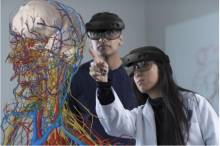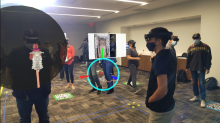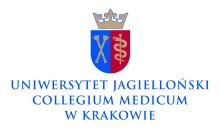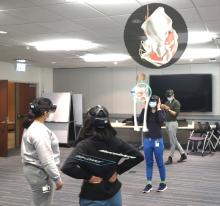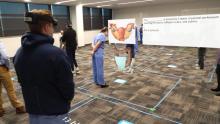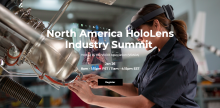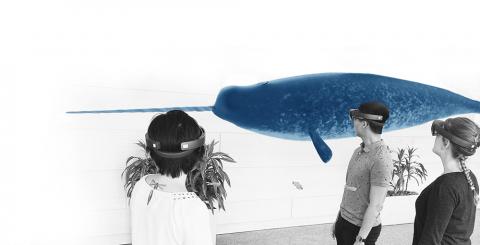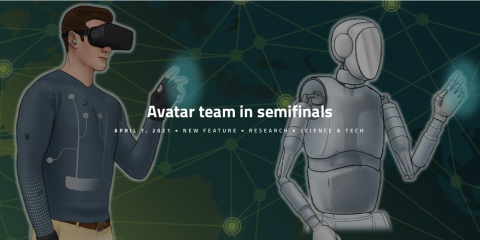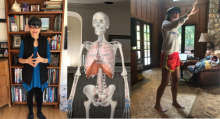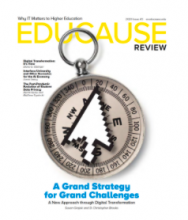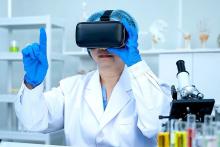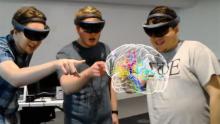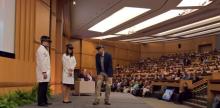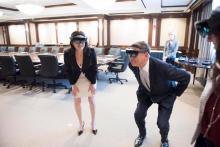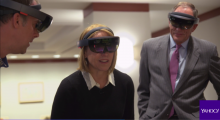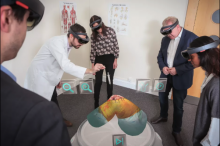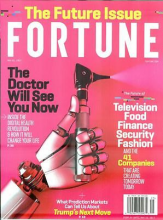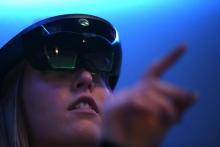Forbes Magazine Feature of HoloAnatomy
January 27, 2023
Case Western University creates Ilumis to commercialize Holoanatomy. The national research university benefitted from a pilot partnership to help develop a number of new applications in diverse areas like anatomy and live performance. As it turns out, the anatomy application, one of the first developed for the HoloLens in 2016, is still one of the best. It’s not tied to HoloLens, either. It will work with Magic Leap or any other spatial device.
New company from Case Western Reserve University helps medical students learn anatomy through holographic imagery
January 26, 2023
Recent coverage of the HoloAnatomy® learning platform on NPR on Thursday morning, January 26, featuring Mark Griswold and Susanne Wish-Baratz from Case Western Reserve University and Mark Day, CEO of Ilumis, which "aims to bring this mixed reality learning technique to students around the world."
"The university developed pioneering HoloAnatomy software that helps teach students about human anatomy, without the cadavers, by using holographic imagery. The software is already used by hundreds of medical students at Case Western, and is licensed to more that 18 other institutions. We'll start by talking about the development of this idea, and what the future holds for holo-technology."
Case Western Reserve University Launches Ilumis
January 17, 2023
Case Western Reserve University (CWRU) developed the HoloAnatomy® Software Suite to teach human anatomy in a more intuitive, cost-effective way using holographic imagery. Building on its long history of bringing influential research into the public domain, CWRU has announced the launch of Ilumis, Inc. to accelerate product innovation, improve partner service, and rapidly scale the potential of this revolutionary learning platform.
HoloAnatomy®: A virtual view of the human body
January 30, 2022
Texas Christian University (TCU), one of our earliest partners of HoloAnatomy®, have produced a multimedia story about their HoloAnatomy® curriculum for TCU360.
The TCU School of Medicine received HoloLens headsets during the onset of the COVID-19 pandemic and had to store them for a year until students were back in the classroom.
At the return of in-person classes, Jonathan Babirak, a mixed reality specialist at the medical school, worked with professors to create "glorified PowerPoints" using HoloAnatomy. Between 10 and 15 faculty members at the school have now been trained to use the software.
Inside the Metaverse: 3D Detailed Anatomical Renderings Revolutionizing Health Care
August 7, 2022
NBC News Headliner about HoloAnatomy® Software Suite
The metaverse is a place where people interact in a virtual space through headset technology. NBC News’ Jake Ward explores the 3D technology allowing three surgeons from opposite sides of the globe to plan an operation together virtually, allowing them to examine detailed renderings of a patient’s brain. Universities like Case Western Reserve are also using this technology as a tool to learn anatomy, replacing the traditional more costly method of cadavers. Not only have researchers found that the software helps medical students learn twice as fast and keep knowledge longer, but it may open this education up to other groups who wouldn’t have had access to this before.
Poland’s Jagiellonian University Medical College brings the Microsoft HoloLens 2 into the classroom
April 13, 2021
Jagiellonian University Medical College in Krakow, Poland, known as one of Europe's oldest academic institutions, acquired Microsoft HoloLens 2 mixed reality headsets to use in the classroom. They have also acquired HoloAnatomy® to teach anatomy for students and aspiring doctors.
"We want to establish an augmented laboratory in the JUMC where students and young physicians can have a look at medical data through Microsoft HoloLens 2." Dr. Klaudia Proniewska, PhD. Eng. in Biomedical Engineering
Feinberg Augments Anatomy Curriculum with Mixed Reality Software
February 7, 2022
Northwestern's Feinberg School of Medicine is customizing HoloAnatomy® to meet the needs of their students in remarkable ways. And the students are embracing their new high-tech curriculum.
“We use this technology not as a replacement for dissection but to augment and enhance the learning of anatomy in a more efficient and effective way,” said Patricia Garcia, MD, MPH, associate dean for Curriculum and a professor of Obstetrics and Gynecology in the Division of Maternal Fetal Medicine and of Medical Education.
'Gasps Erupt Throughout the Room' as TCU Students Experience HoloAnatomy® Software
January 30, 2022
Texas Christian University students step into the future of learning as they experience the HoloAnatomy® Software Suite for the first time on their campus.
"This is how the TCU School of Medicine teaches anatomy. The school uses HoloAnatomy software in addition to dissection labs to teach its students anatomy structures by way of interactive holograms. The school is one of the first
medical institutions to use augmented reality and is witnessing firsthand how the technology transforms the classroom."
HoloAnatomy®: CWRU's MR Learning Solution, Used by Oxford University
December 3, 2021
HoloAnatomy is a VR learning product created by the Case Western University Team, in collaboration with the Cleveland Clinic and Microsoft HoloLens. Expectedly, HoloAnatomy works only with Microsoft HoloLens, but this in no way takes away from its power-packed feature set.
Recently, HoloAnatomy has received a lot of attention and positive press from Microsoft, featured at two of its online events in January.
North America HoloLens Industry Summit
January 26th 2022
This year we are thrilled to announce our partnership with the VR/AR Association to further extend the opportunities to learn more from Microsoft and industry leaders about HoloLens best practices, core use-cases, and featured stories. This year’s Summit will highlight even more incredible speakers, more opportunities to learn, and more opportunities to connect with your peers and professionals across industries. We are so grateful to have you join us again! Join our Executive Director of Global Sales Nancy Farrow at this exciting event!
Five Augmented Reality Apps Revolutionizing Healthcare
November 29, 2021
Microsoft’s cutting-edge augmented reality technology is transforming the way medical students learn about the anatomy of their patients.
Unlike before, where classes on human anatomy were limited to passive, didactic teaching methods, HoloAntomy® now provides a fully interactive experience where students can collaborate and learn in ways that were once considered impossible.
Anatomy’s Andrew Crofton named 2021 John S. Diekhoff Award for Graduate Teaching recipient
May 2021
In each of his anatomy classes, Andrew “Andy” Crofton tailors his teaching method to the students as individuals—a style they say creates an environment in which they feel respected and motivated to achieve at their highest level. It’s among the many reasons Crofton, assistant professor of anatomy at Case Western Reserve University School of Medicine, will receive the John S. Diekhoff Award for Graduate Teaching during the commencement convocation Sunday, May 30.
Anatomy’s Darin Croft appointed editor-in-chief of the Journal of Mammalian Evolution
February 2020
Darin Croft, professor of anatomy, was appointed editor-in-chief of the Journal of Mammalian Evolution, a peer-reviewed international journal that publishes a wide variety of research spanning morphology, molecular biology, paleobiology, genetics, ethology and ecology, and other subjects related to mammalian evolutionary biology.
What are the potential uses for the Microsoft HoloLens?
April 2020
The Microsoft HoloLens deliver an immersive Mixed Reality experience which allows users to explore experiences otherwise impossible. Mixed Reality is proven to engage and drive retention of information in a compelling way as developers continue to expand applications into various areas of study. Because organizations and individuals are constantly developing more applications for HoloLens, the opportunities continue to expand. New applications are rolled out and made available similar to the way in which applications are rolled out to tablet devices.
The landscape for applications will continue to expand, and CWRU has been recognized as leading the charge in innovation. An example of this was a partnership with CWRU to develop a narwal exhibit for the Smithsonian. This exhibit gave visitors new insight into the mysterious arctic mammal with the ability to experience their habitat in a mesmerizing manner narrated by Meryl Streep.
What better way is there to learn the narwal’s tusk is actually a tooth?
Learn more about this project with Interactive Commons here.
Case Western Reserve-led team among 38 from 16 countries selected to compete for $10 million prize
April 2020
A team led by Case Western Reserve University biomedical engineer Dustin Tyler has made it a step closer to the finals in a global competition to develop an “Avatar System that will transport a human’s sense, actions and presence to a remote location in real time, leading to a more connected world.”
On Monday, the XPrize Foundation—the same organization behind $10 million of financial support in 2004 to make the first privately funded human spaceflight—announced its semifinalists in a $10 million “global competition: 38 teams from 16 countries.
Kent State University College of Podiatric Medicine Partners with HoloAnatomy® Software Suite
February 2021
Pictured: Senior Associate Dean, Bryan Caldwell, DPM, and Associate Professor of Pre-Clinical Sciences, Stephanie Belovich, Ph.D.
Kent State University College of Podiatric Medicine (KSUCPM) has further expanded its cutting-edge, advanced technologies by partnering with Case Western Reserve University’s HoloAnatomy® Team as it implements HoloAnatomy® mixed reality software into the college’s modern educational environment.
KSUCPM faculty and staff are among the leading podiatrists and medical scientists in the country which is why HoloAnatomy® Software was the ideal fit. Through HoloAnatomy® Software Suite, KSUCPM anatomy professors will instruct their students by adopting immersive and engaging holographic learning experiences. Faculty are delighted with the flexibility they have to create their own customizable anatomical content, with access to more than 8,500 exquisitely detailed 3D anatomical objects, divided between female and male models. The new digital curriculum is then presented to students using Microsoft HoloLens 2 devices.
”We are excited to introduce our students to HoloAnatomy®”, said Jill Kawalec, Ph.D., Professor and Division Head of Preclinical Sciences at Kent State University College of Podiatric Medicine. “The addition of holographic instruction to our anatomy courses will enhance student learning, as it will allow them to visualize the structures in a way that is perhaps not possible in a cadaver alone. As a result, our students will develop a stronger foundation in anatomy upon which will build upon their continued training to become superior podiatric physicians and surgeons.”
Case Western Reserve University HoloAnatomy® Team is pleased to welcome Kent State University College of Podiatric Medicine as a new partner joining other esteemed institutions including Massachusetts General Hospital, University of Oxford, Northwestern University, Texas Christian University, and California Health Sciences University.
Global first in mixed-reality education during COVID-19 pandemic
September 2020
Newswise — CLEVELAND—The developers of Case Western Reserve University’s signature HoloAnatomy mixed-reality software for the Microsoft HoloLens knew they were likely achieving a global first this Spring when they quickly pivoted to the first-ever, all-remote anatomy course when the COVID-19 pandemic kept 185 first-year medical students from coming to campus.
Case Western Reserve University achieves apparent global first with mixed-reality education during ongoing COVID-19 pandemic
September 2020
CLEVELAND — As the world pivoted to life at home amid the ongoing COVID-19 global pandemic, Case Western Reserve University's School of Medicine found an innovative way to engage their students.
Remote HoloAnatomy® Study Published in JAMA
September 2020
JAMA, or the Journal of American Medical Association, published the study that we performed on the experience and assessment of the Remote HoloAnatomy® Software course, delivered in the spring semester of the academic year 2019-2020.
HoloAnatomy® Software Featured in EDUCAUSE Digital Review 2020
August 2020
EDUCAUSE Review, a magazine that takes a broad look at current development and trends in technology to see how it relates to college and universities. This magazine dives into how the IT community works together with the higher education institutions to enhance their future. This issue of EDUCAUSE Review featured the HoloAnatomy® Software Suite showing that the world is adapting to changes. “This pandemic may break higher education. Yet it may also remake it, by forcing shifts that seemed unimaginable just a few months ago.” In this issues, the HoloAnatomy® Software Suite was featured as 3D learning, expressing that education doesn’t just exist at college or university as the physical sense, but also creating a digital world for students to discover and expand their knowledge.
Can medical students learn anatomy without a cadaver? COVID-19 is forcing the question
The “first cut” in a gross anatomy class, when a student uses a scalpel to slice into the skin of a cadaver, is a nerve-wracking experience for anyone embarking on a medical career. But it’s almost sacred, too. As students begin their hands-on anatomy education, they also have to ruminate on life and death, and their relationship with their future patients.
Universities Get Creative With Technology Due to Coronavirus Closures
Universities scrambled over the past month to move classes online as the coronavirus pandemic forced campus closures. With social distancing likely to extend through the spring semester, chief information officers are taking stock of their actions, identifying quick solutions that could one day become permanent fixtures on a postcrisis campus.
Mixed Reality: A Revolutionary Breakthrough in Teaching and Learning
July 2018
Teaching and learning with technology, prior to this point, was mostly limited to supplementary collaboration tools for communication: learning management systems and electronic texts. The technology was simply an electronic aid to traditional didactic teaching, adding a little modern muscle to the same ways we have taught and learned for decades. We are now entering an era where technology really does the teaching, providing an entirely new mechanism for learning.
IC at Cleveland Clinic's "Ideas for Tomorrow" with Microsoft CEO Satya Nadella
June 2017
The IC’s work on the HoloAnatomy® Software was featured on stage at Cleveland Clinic’s Ideas for Tomorrow lecture series with Satya Nadella and Toby Cosgrove. After a few days of preparation, the IC team was able to demonstrate a live broadcast from our own custom camera rig showing the holograms that the on-stage presenters could see. The demonstration begins at about 45 minutes into the linked video. For the record, Toby’s request to see the brain at the end was completely spontaneous. Thankfully the IC team is always prepared!
Sheryl Sandberg Gets a Tour
June 2017
Sheryl Sandberg, the COO of Facebook and founder of Leanin.org, came to Cleveland as part of Cleveland Clinic’s Ideas for Tomorrow lecture series. During this visit, she got a demo of our HoloAnatomy® Software from Erin Henninger and Kerrin Sunshine, and afterwards she posted about it!
Scientists Are Turning Your Body Into Holograms. Doctors, architects, and even elevator technicians are using artificial reality to re-design their work
June 2017
Katie Couric Visits IC
May 2017
Journalist Katie Couric visited Cleveland as part of her reporting series “Cities on the Rise.” As part of this story, she went on a virtual anatomy tour with Toby Cosgrove and Mark Griswold. This was an experience of an early version of the curriculum that will be used in our new Health Education Campus. Mark also got to hold her hand for a moment.
The Unreal, Bleeding-Edge Tech That’s Helping Doctors Make The Cut
June 2017
I couldn’t quite decide whether it was his agonized expression or the detailed tattoos covering his arms that bewildered me the most, but the full-size dummy in a hospital gown wasn’t there to freak people out. He was there to help improve health care for U.S. veterans, part of the technology arsenal of the Veterans Health Administration’s high-tech SimLearn facility, housed in an impressive building on the outskirts of Orlando.
HoloAnatomy® Software Featured in Fortune Magazine
April 2017
Fortune Magazine Editor in Chief, Cliff Leaf, visited the Cleveland Clinic to discuss new disruptions in healthcare. As part of this visit, he tested the HoloAnatomy® Software program being developed at the Interactive Commons with faculty director, Mark Griswold. Besides seeing the body in detail, Cliff said, “Seeing this demo with Dr. Cosgrove, a former heart surgeon who pioneered techniques for valve repair that are widely used to this day, was an extra treat.”
How Virtual Anatomy Will Change Med School
Last week I spent a day at the venerable Cleveland Clinic—the city’s best-known celebrity, perhaps, next to this guy. The hospital (and really, it’s a hospital system with outposts in several cities in the U.S. and abroad) has always been on the spear point of progress—but that has been particularly true over the past 13 years, under the guidance of CEO Toby Cosgrove.
HoloAnatomy® Software App Named Finalist for International Science Media Awards
August 2016
The HoloAnatomy® demo app designed by the Interactive Commons to highlight how mixed-reality technology can transform education, is a finalist in the Jackson Hole Science Media Awards, an international competition that recognizes the best in science communications across a broad range of media. The HoloAnatomy® app has two competitors left in the “Virtual Reality and Augmented Reality” category – one is globally renowned naturalist and broadcaster Sir David Attenborough, and the other is Google. The winners will be announced in September.
Microsoft Wows Build With HoloLens Hologram Show. HoloLens project head Alex Kipman serves up an eye-popping showcase of Redmond's augmented reality tech.
April 2015
Several years ago, Microsoft released a video called "Productivity Future Vision (2011)," which showed a business traveler navigating a city overlaid with useful information and holographic media presenting itself on any glassy, flat surface available—car windows, buildings, even credit card-sized mini-devices.



